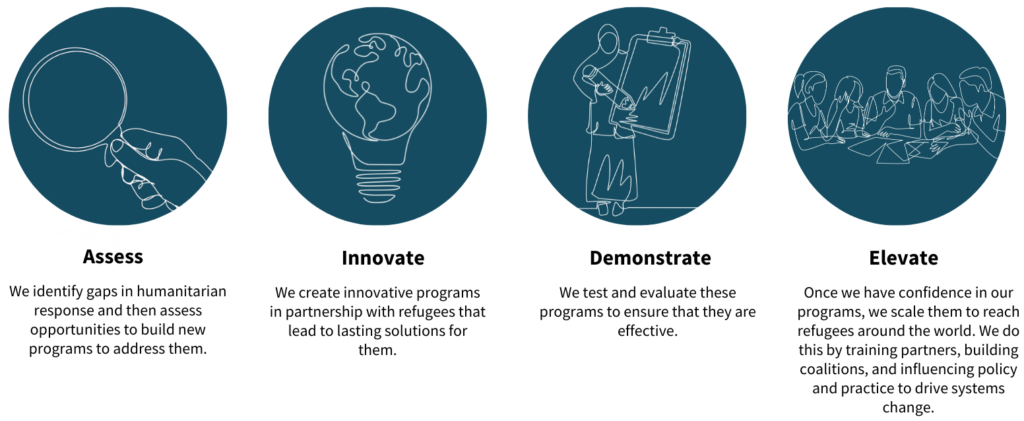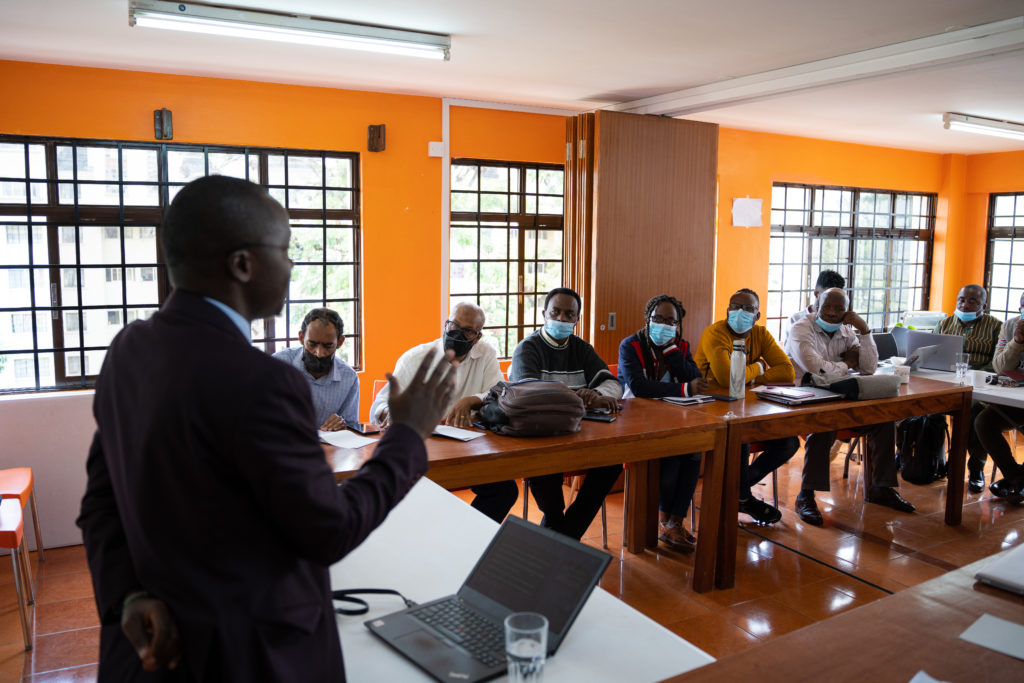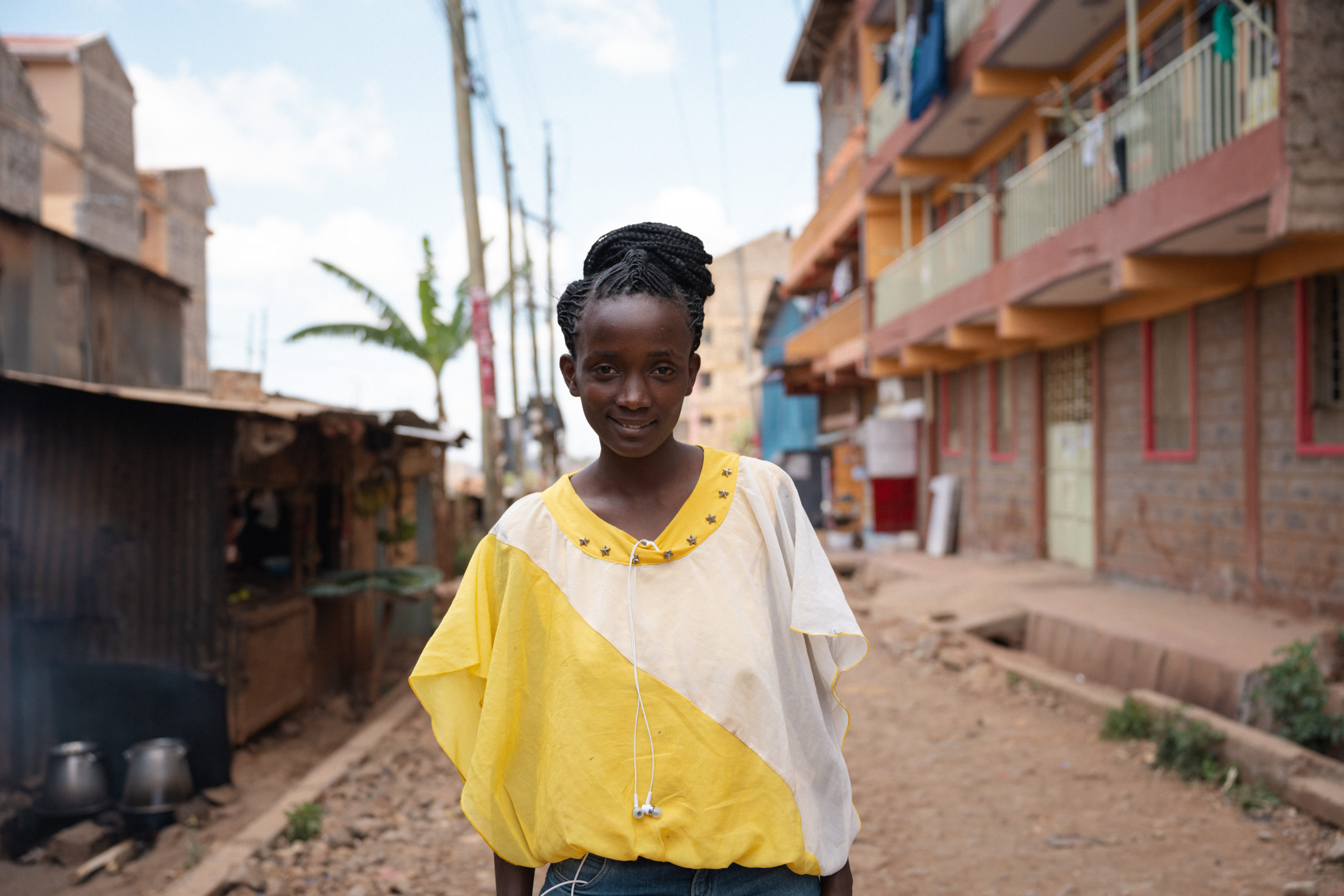In 2021, RefugePoint launched a three-year strategy. In it, we highlight the importance of reimagining what refugee response looks like in partnership with refugees themselves, and driving large-scale systemic change to support lasting solutions.
As we arrive at the midway point, I’ve reflected on the progress we’ve made and where we’re headed as an organization. I’m sharing these thoughts here.
OUR CORE APPROACH
Our work is focused on a single outcome: helping refugees find a solution that enables them to thrive and lead dignified lives. We do this in two ways. The first is to help refugees stabilize, earn income, and integrate in the countries to which they have fled so they can meet their own essential needs—we refer to this as self-reliance. The second is to help refugees who can’t remain safely where they are to permanently relocate to a new country to rebuild their lives. We do this through resettlement and other pathways to safety, such as family reunification and labor mobility.
We use a distinctive approach. We develop innovative programs, demonstrate that they work, and scale them. We call this our AIDE framework through which we drive large-scale change:

RefugePoint’s programs are built on our core work around resettlement and self-reliance. Our resettlement efforts have opened up opportunities to build other relocation program pathways through family reunion, labor mobility, and other humanitarian channels. Our flagship program for self-reliance, the Urban Refugee Protection Program in Nairobi, Kenya, has opened up opportunities to partner with others to build the Refugee Self-Reliance Initiative in order to promote self-reliance on a global scale.
At the halfway point of our three-year strategy, there are two overarching points that we’ve learned:
- Our Strategic Objective of Resettlement and Other Pathways is More Necessary than Ever.
The world is now at a highwater mark of forced displacement with over 100 million people who have fled from home, including over 30 million refugees. The current willingness of governments to bring in refugees underscores the importance of our focus on expanding resettlement and other pathways, and the urgency of doing so as quickly as possible. The current US and Canadian administrations, among others, have focused on bringing in more refugees, and creating new pathways to do so. But, political winds and administrations shift. The next changes could lead to a more hostile orientation toward refugees. We need to take advantage of this unique window.
Our strategic objectives include expanding the reach of the traditionally limited scope of resettlement. Many refugees fleeing life-threatening situations find themselves in countries where there is little or no access to resettlement. We are working to rectify that so refugees have access no matter to which country they’ve fled. This can increase the number of refugees identified for resettlement so governments can fill and expand their quotas. It also protects people from risking onward journeys. (In too many places, resettlement isn’t available, and refugees are subjected to what’s considered a “pull factor”— risking dangerous journeys to get to a location from where resettlement is taking place.)
We think of expanding resettlement possibilities as equitable access to resettlement. A primary mechanism for this envisioned expansion is to deploy our own staff to locations across Africa, the Middle East, and other countries that fit our strategic objectives, and train and support other organizations to identify refugees for resettlement. To complement this operational expansion, we authored a now-widely-cited report, Preserving the Humanitarian Nature of Resettlement, to highlight the importance of equitable access to resettlement.
Our strategy also includes building new resettlement-related programs that are distinctly suited to our values and capabilities. In the past few years we’ve built labor mobility and family reunion programs. We aim to embed these programs into the international humanitarian response system so they can scale widely.
Our 2021 Annual Report highlights our accomplishments from the first year of our strategic plan. Some of the resettlement and other pathways highlights include:
- Helped 12,088 people in 30 countries access pathways to safety and trained 2,474 partner-agency staff on how to help refugees access resettlement and other pathways to safety
- Released a report, Preserving the Humanitarian Nature of Resettlement, which focuses on the importance of equitable access to resettlement.
- Achieved the first arrivals in Canada through the Economic Mobility Pathways Project (EMPP)
- Helped 551 refugees to reunite with family members, including many unaccompanied children.
- Launched the Sponsor Circle Program for Afghans, an unanticipated emergency response to help Afghans evacuated to the US to resettle into communities across the country. The program enables Americans to form groups and sponsor Afghan families. We used private funds to help launch this program in collaboration with the Community Sponsorship Hub and other partners. It is now a recognized model of sponsorship, is expanding to include Ukrainians, and may be available to other refugee populations soon.
- Our Strategic Objectives for Self-Reliance are a Key to the Future of Humanitarian Response
The Ukraine crisis, just like so many others before it, has highlighted the importance of enabling refugees to become self-reliant. The vast majority of refugees are stuck for one or two decades outside of their home country. Emergency humanitarian aid – tents, food, and other basic support – for that length of time does not provide a path forward. Refugees, as they say themselves, need to find a way to stand on their own two feet and build self-sufficient lives. The former UN Secretary-General, Ban Ki-moon, emphasized this point saying that “Millions are trapped in dependency on short-term aid that keeps them alive, but falls short of ensuring their safety, dignity, and ability to thrive and be self-reliant over the long-term.” Self-Reliance is one of the four pillars of the UN’s Global Compact on Refugees, which is rooted in the Sustainable Development Goals.
Before self-reliance was a global objective, RefugePoint was building a flagship program to advance this goal for refugees in Nairobi, Kenya, thanks to our private funding and our partnership with refugees themselves, which has guided our vision.
Our strategic objectives include pioneering self-reliance programming and measurement through our Urban Refugee Protection Program in Nairobi. We’ve found that the impact and learning from this program can play a pivotal role in defining better strategies for the field more broadly. We are also partnering with refugees and their communities so that their voices, needs, and aspirations are the guideposts for our programs.
Since 2021, we have convened and provided funding and technical guidance to a cohort of refugee-led organizations (RLOs) in Kenya. A leader from one of the RLOs, Youth Voices Community Organization, said that “RefugePoint is in the forefront to support and engage refugee-led organizations as service partners and not just beneficiaries or mobilizers.”
The Urban Refugee Protection Program we’ve built, which we view as a place where best practices are codified so we can influence and train others, was part of the inspiration for the Refugee Self-Reliance Initiative (RSRI). The RSRI, which was built in partnership with the Women’s Refugee Commission, is a global multi-stakeholder collaborative effort that aims to transform the humanitarian response paradigm toward self-reliance opportunities for refugees as opposed to emergency aid. This effort is now underway and has 34 partners in 23 countries reaching 150,000 people with self-reliance programming. Our strategic goal is a paradigm shift from emergency aid toward self-reliance programming.
Here are some of the highlights from 2021:
- Created an accountability and oversight committee composed of refugees in Nairobi to increase refugee involvement in program design, oversight, and monitoring.
- Convened and supported refugee-led organizations in Kenya.
- Helped to start or maintain 122 refugee-led businesses in Nairobi, a critical component of the self-reliance journey.
- Provided intensive services in Nairobi to 1,636 refugees, of which 557 achieved self-reliance and graduated from the program.
- The Refugee Self-Reliance Initiative’s partners reached nearly 150,000 refugees with programming that puts them on a path to self-reliance.

ENVISIONING THE NEXT FIVE YEARS
Now that we are halfway through our 2021-2023 strategy, and have new accomplishments in hand that underpin future action, we are starting to turn our attention to the near future. What should the refugee response landscape look like by 2027? How do we best bring our distinctive approach and perspective to making our vision a reality?
By 2027, the responses to refugee crises must be substantially different from today. There are fundamental shifts underway that will reshape humanitarian action. These shifts include moving toward a refugee-centered approach and ensuring that refugees are decision-makers, leaders, and guides in the programs that impact their lives. In addition, we must use this moment of crisis to build new resettlement and other pathway programs that will last into the distant future. There are also urgent needs to transform humanitarian response toward self-reliance models. A common thread among all these efforts is that they are centered around the values of dignity and safety.
Some key areas of focus for the near future to help bring about these essential changes include:
- Partnership with Refugees: RefugePoint’s deep dive into working with and funding refugee-led organizations in Kenya can, hopefully, be a guidepost for learning. We will continue to learn from others as we embrace this journey to center refugee leadership. Once we have lessons that are worth sharing, we will use the RSRI’s platform and other relevant forums to disseminate any best practices and learnings. We are also looking at ways to elevate the voices of people with lived experience. One example is the recent Skoll World Forum discussion that we organized: Centering Refugee Voices in Humanitarian Response and Philanthropy.
- Mainstreaming Relocation Programs: There are pivotal shifts underway in the resettlement and other pathways space which will expand the landscape of relocation opportunities for refugees. RefugePoint has been a catalyst for starting family reunion and labor mobility pathways programs. We aim to expand access to these pathways by continuing to build the programs, prove their success, train and support others to take them up, and draw more funding and attention to this space so that the field is adequately resourced to maximize the opportunities.
Here’s a brief look at the essential needs, opportunities, and future potential for these programs.
Family Reunion Pilot Project. In the next five years, we aspire to mainstream our family reunion program so that it expands beyond our initial pilot countries of Libya, Egypt, Sudan, Ethiopia, and Chad, and is available to refugees across the world. RefugePoint plays a unique role in this new program, launched in collaboration with UNHCR and the International Refugee Assistance Project (IRAP), identifying unaccompanied children in a number of countries spanning Sub-Saharan and North Africa and working closely with them to ensure the reunion process with relatives in EU and other countries. The most recent estimates we have are that for every individual resettled, at least two could access family reunion.
Family unity – especially children with their parents — is a basic human right. So family reunion is a rights-based solution, benefitting from preexisting immigration legislation in most countries and protecting it from the political fluctuations that resettlement is subject to. If we can effectively build this pathway, it will be available for refugees even if resettlement is reduced, as it was during the previous US administration, or stopped. If family reunion opportunities are not available, children and others often resort to traffickers and embark on dangerous and often even deadly journeys. Despite the compelling need for family reunion, for a variety of reasons, many unaccompanied children and others could not access family reunion opportunities before the pilot program.
Economic Mobility Pathways Project (EMPP). In the past year, RefugePoint’s EMPP project saw the first arrivals in Canada. Our discussions with the Canadian Minister of Immigration and other partners have illuminated the significant political will behind this program, and the dramatic opportunity available to match refugee skills with employment needs that can only be filled through immigration. One leading employer who is bringing in dozens of additional RefugePoint candidates said that he hopes dozens will quickly become hundreds and then thousands. RefugePoint built this program in collaboration with the Canadian government and other partners. Beyond the foundational nature of our work – RefugePoint and Talent Beyond Boundaries, a leader in this space, are the two non-profit organizations building this pathway – we have brought our distinct refugee protection lens to this work to ensure that family unity and other essential protection elements are built into the DNA of labor mobility opportunities. We are also partnering with the first recipients of this program to ensure their voices and insights guide future action and growth. With other governments starting or considering labor mobility, this is a solution with vast potential.
In its strategy on resettlement and complementary pathways, the UN Refugee Agency estimates that over a decade from 2019 to 2028, three million refugees will access relocation programs— one million through resettlement and two million through other pathways. Family reunion and labor mobility are the two other largest opportunities. RefugePoint’s work is a key to unlocking these opportunities.
Confronting the Unknown: New crises will emerge that are currently unforeseen. There will undoubtedly be a need for urgent action to find solutions. As an organization that has been called on to engage in new emergency efforts due to our strategic position as a thought leader, innovator, and front-line identifier of refugees for resettlement and other pathways, we recognize the need to have resources ready to respond to emerging needs. Ideally, we would have an emergency response team ready to deploy. Times in the past when we’ve been able to manage but could have done more with such a team include our work to reunite unaccompanied Yazidi children who had escaped ISIS captivity with their parents in Canada, and our efforts to help launch, in collaboration with the UN Refugee Agency, an emergency resettlement effort for unaccompanied minors and other refugees in Libya and resettle them to EU countries.
Self-reliance: Arguably the most fundamental shift in humanitarian action, and the one that will impact the greatest number of people, is the increased momentum around self-reliance programming. By 2027, the Refugee Self-Reliance Initiative aims to change the paradigm of humanitarian response toward self-reliance. We have built a roadmap to achieve that goal that includes reaching five million people in five years, influencing at least 15 funders to invest hundreds of millions in self-reliance programming, and supporting 100 partner agencies. Our flagship Urban Refugee Protection Program in Nairobi is a leading partner in this effort and contributes learning and operational guidance that will influence this expansion and the field broadly.
CONCLUSION
RefugePoint’s past successes point toward the future opportunities we can capitalize on with adequate resources. Our innovations aim to expand opportunities and funding far beyond our direct operational capacity.
Overall, the time frame through 2027 will likely bring about some of the most significant changes in humanitarian response that have occurred in decades and will last long into the future. Enabling refugees to be the lead participants in programs that impact their lives, unlocking opportunities for them to innovate and earn an income, and centering the value of dignity in humanitarian response are all possible on a global scale. Along with these shifts, we anticipate a growing awareness of refugees as contributors rather than victims; we also aspire to see countries compete to bring in refugees. As the world reaches previously unimagined milestones of forced displacement, we must also strive for new programs and ideas that transform humanitarian action. RefugePoint’s very founding was based on new insights and the need for action to address unmet and urgent needs. Reaching those in desperate need, centering refugee voices and insights, bringing innovation to the forefront of refugee response, and catalyzing changes in humanitarian action that expand solutions are in the DNA of our organization. Today such insights and action are needed more urgently than arguably anytime in the past.
